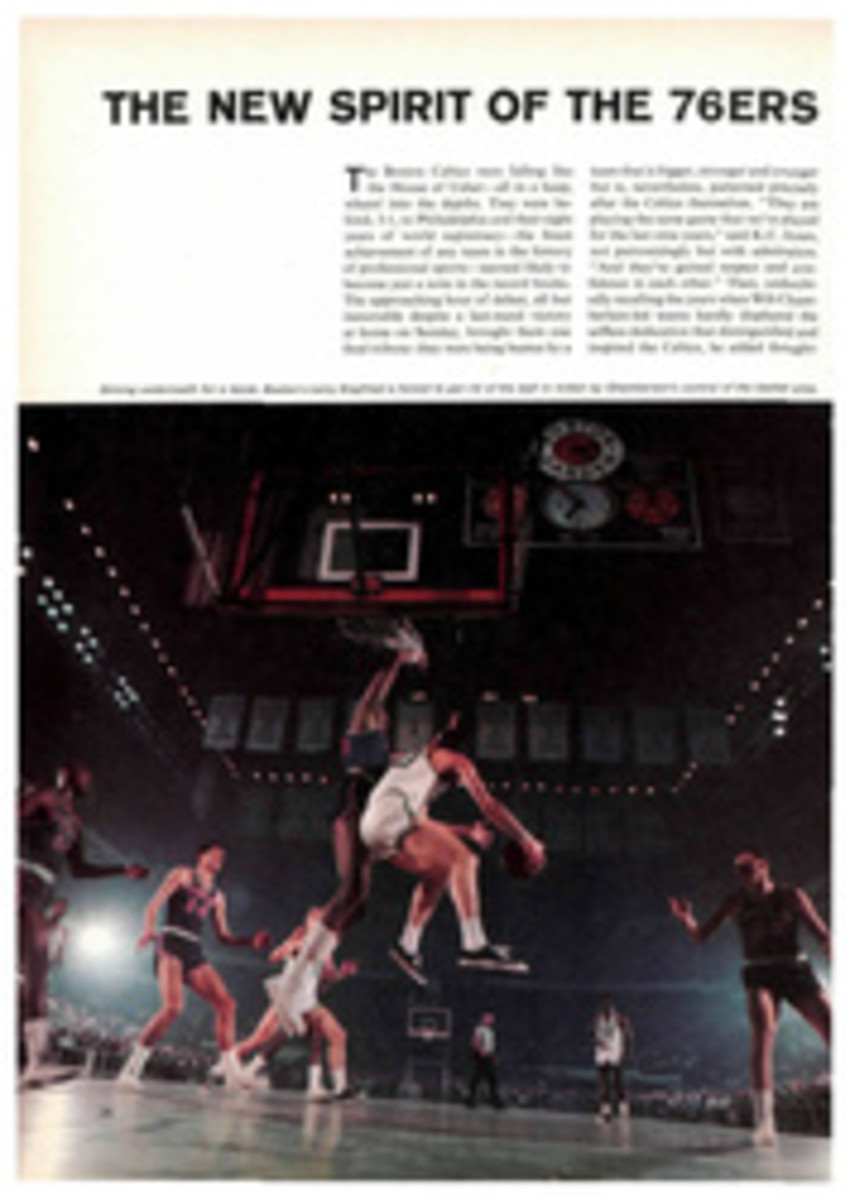
The times came for two teens
Some day in the far, far distant future, U.S. swimmers will stop outdistancing themselves and allow the aquatic record book to regain some of the tranquillity it once had. Sometime, perhaps, but not, apparently, any time soon.
Last week at Joe Perkins Natatorium, a refurbished gymnasium that sits on the north side of Dallas as part of the Southern Methodist campus, the Amateur Athletic Union put on its annual indoor short-course nationals a bare fortnight after the collegiate swimmers had set 12 American records in the NCAA get-together in East Lansing, Mich. While a few of the erstwhile campus heroes chose to rest on their laurels (read that as "backsides" in some big instances), enough of them did not, so that with the aid of a pair of 17-year-old high school upstarts, they gave the record book still another and, under the circumstances, quite surprising beating.
Pete Daland, the glib Southern California coach, neatly summed up the unusual situation when he said, "The story of this meet is a bunch of tired collegians who reached their peak two weeks ago against a bunch of high-schoolers, some of whom are scared, but all of whom are ready and eager."
For most of the collegians, this was their third major meet in five weeks, counting conference or regional and NCAA competition. Many of them were losing interest in swimming, even though the meet was serving as the only tryout for places on the U.S. Pan Am team. SMU's annual spring fraternity-sorority tea party, known as Mod-Nada Madness, was in full swing, prompting this Friday afternoon dialogue between two swimmers from a Big Ten school:
"What the hell are you doing?"
"I'm trying to pick up a date for Saturday night."
"You've got a swimming meet to worry about before Saturday night."
"I know, I know."
"You're a fool."
No doubt he was, particularly in light of the competition he faced. There were, for instance, those two 17-year-olds from Santa Clara (Calif.) High School. Here are the proving waters, as even non-swimming types are becoming aware, of the world's most successful swimming coach, George Haines. One of the originators of age group swimming 15 years ago, Haines coaches the Santa Clara Swim Club, too, and it is sometimes difficult to tell the difference between his school and his club swimmers.
The first of the pair is Fred Haywood, a senior backstroker, who until last year had spent his summers surfing off the coast of Kahului, a little town on the Hawaiian island of Maui. For three years Haywood attended Hawaii Prep Academy, which did not even have a swimming pool until Coach Gerry Damon and a school math teacher built an eight-lane frame and floated it out into the middle of the Pacific Ocean, where academy swimmers practiced among the sharks and jellyfish. "It was a bit unnerving," said Haywood.
Damon quickly recognized that Haywood had more potential in the backstroke than in the freestyle and put in a call to Haines, who promptly invited Haywood to Santa Clara. The wheeling and dealing all ended with a victory at Dallas in the 100-yard backstroke, Haywood's first national title of any consequence. He beat Charles Hickcox of Indiana, the NCAA champion, and while he set no record for the event he did exhibit an enviable canniness.
"I knew I was an upstart, an outsider, a nobody," he said, "and I knew they would try to take me out [set a fast pace] and hope I couldn't bring it in. So I never looked at Hickcox or anybody else. I just went as fast as I felt I should." It was fast enough by an easy and a comfortable half length.
Haywood did show he was fallible. In the 200-yard backstroke preliminaries he was leading his heat going into the sixth turn when, as he put it, "I made the turn but there wasn't any wall there." The error cost him two seconds and a place in the finals.
Mark Spitz made no mistakes in either the 200- or 100-yard butterfly. Like Haywood, Spitz is not a native Santa Claran. He does, however, come from Sacramento, which is a good deal closer to Santa Clara than Kahului. His parents (as have the parents of many good swimmers) moved to "Hainesville" in 1964, where George promptly changed Spitz from a promising distance freestyler to an even more promising butterflyer. Haines said, "I looked around and saw where we—the U.S., not Santa Clara [and how many coaches can talk like that?]—needed help for the 1968 Olympics and figured the fly would be our weakest spot." So Mark Spitz became a butterflyer, and last Friday and Saturday the high school junior, who has already made swimming trips to Israel, Brazil, Mexico and Germany, set American records in both the 200- and 100-yard events.
He swam the 200 in 1:50.6, breaking Fred Schmidt's two-year-old record by .8 second and beating NCAA Champion Carl Robie of Michigan by more than a second. He surpassed that performance a day later in the 100, when he swam an astonishing 49.9 to beat Princeton's Ross Wales, the—ho hum—NCAA champion at that distance, in a marvelous come-from-behind victory that seemed to confirm what both Spitz and Wales believe: Spitz has Wales totally and completely psyched.
"He always does that," said Wales, who swam a not-bad 50 flat himself, .2 under the old record, of which he was a coholder. It was Spitz's third straight win over Wales.
Spitz is 5'11" when he stands straight, which is seldom. He has a weirdly supple body that allows him almost unreal looseness before an event. As Spitz had planned, Wales led the first three lengths of the 100 but, as he had not planned, Wales led by too much—two feet, a lot in the tiny allowances of championship swimming—after the third turn. "I wanted him to set the pace," Spitz said, "but not by that much." Spitz got to work and finally passed Wales 10 yards from the finish.
Three weeks earlier he had told Haywood that he planned to break 50 seconds, but had he really expected to go that fast? Well, no, Spitz said. But "if you swim to win in a race that short the time comes." It did, and another seemingly impenetrable barrier was shattered.
While many collegians could not duplicate their NCAA performances, at least two freestylers, Don Schollander of Yale and UCLA's Mike Burton, exceeded them. For Schollander, it was easy. Recovering from the flu, he had won nothing in East Lansing. In Dallas he showed what it meant to be well. First, he anchored Yale's winning 400-yard free-style relay team in a good but nonrecord effort. Next he won the 200-yard free-style from Stanford's (and Santa Clara's) Greg Buckingham, who last week found himself in the throes of an ailment as debilitating as flu—food poisoning. Schollander's Dallas victory reversed his and Buckingham's finishes at Michigan State. It also restored Schollander's American record.
Schollander saved his best effort for the last event on the three-day program when he anchored the Elis' winning 800-yard freestyle relay team with a 1:39.5 leg. This, allowing a maximum of one second for the flying start, was still .7 second under Schollander's day-old American mark for 200 yards.
In the chlorinated eyes of many, however, the outstanding individual performance of the week was turned in by Burton. Swimming practically by himself after the first 300 yards, the UCLA sophomore won the 1,650-yard freestyle—swimming's equivalent of the mile run—in 16:08. That was 9.5 seconds better than his winning time in the NCAAs, and that, in turn, had been 9.8 seconds ahead of his standing American record, set in the AAU short-course competition last year.
"Talk about Jim Ryun winning the Sullivan Award," said one coach even before Burton got to Dallas. "Look at what this guy's done."
Yet the performances by Spitz and Haywood were easily the most significant events on the hot Texas weekend. They prompted Indiana's Jim Counsilman to say, "I don't see how anybody will beat the U.S. in international swimming—ever."
Not, at least, as long as there are youngsters like Spitz and Haywood who don't know enough to respect their elders—or the record book.
PHOTO
BUTTERFLYER MARK SPITZ (FOREGROUND) CHURNS A FOAMY PATH THROUGH FIRST LAP ON WAY TO AMERICAN RECORD IN THE 100

